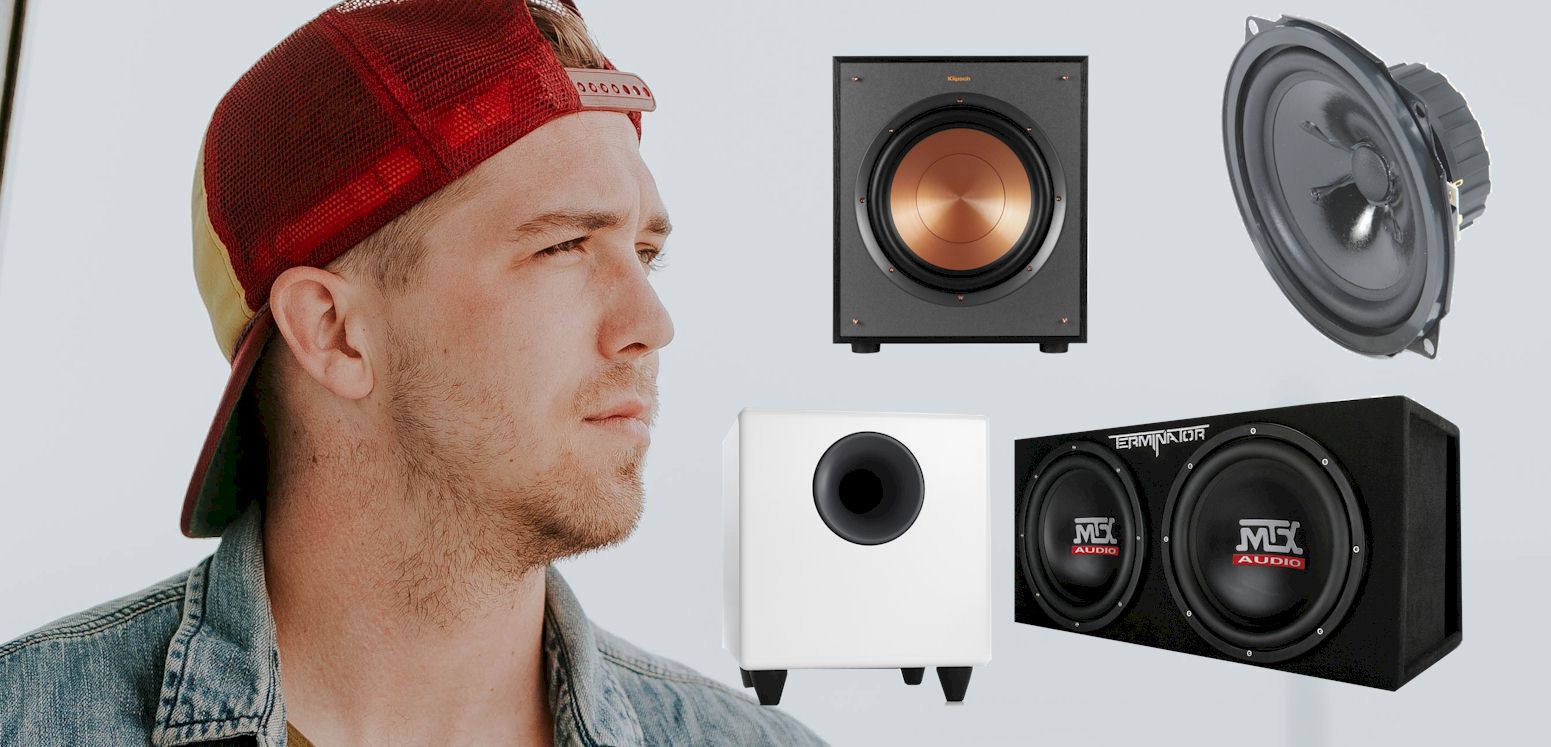Subwoofers are loudspeakers that are programmed to reproduce low-pitched sub-bass and bass, also known as audio frequencies. The difference between a woofer and generic speakers is that standard speakers recreate wider frequency ranges. However, they lack the deep bass.
Due to this distinction, even a few years ago, subwoofers were renowned for being unique among music enthusiasts and top-tier professionals. However, due to the multipurpose of subwoofers and their demand, the consumer market has also shifted.
Now, it is a necessity to own subwoofers in any home theater too. The tricky part about subwoofers is that they are an absolute necessity, yet they have complex and high-end performance. The entire mechanism of subwoofers is pretty interesting.
But, how does a subwoofer work? If you're intrigued about these full-range, powerful speakers, stick with us. We will reveal every minute detail about what they are and how they work.
Contents
What Is A Subwoofer:
Subwoofers have everything to do with the bass. These are speakers who can deliver the lowest frequencies ranging from 20 to 200Hz. Because of its lowest frequency reproducing technology, it sets them apart from any other speaker.
Generally, these lower frequencies can also originate from pipe organs, bass guitar, or kick drums. However, subwoofers can also produce 80Hz for systems that are THX-certified and 100Hz for live-sounding systems. Consequently, subwoofers can never be used independently and require a loudspeaker as they are only meant to augment the sound system.
The parts of a subwoofer include a loudspeaker enclosure generally made from wood that can resist deformation by resisting air pressure. Subwoofers can be made in various designs ranging from horn-loaded, bass-reflex to even transmission lines, each of them having differing trade-offs, cost, and efficiency.
But that's not it. As subwoofers can have an array of configurations, they can be passive or active. Let's see what distinguishes them.
Related: clean a speaker
Active Subwoofers
The amplifier has a built-in active unit in these. These subwoofers require their own AC power source, and the sound quality is no less than those we see in live performances.
Passive Subwoofers
On the contrary, passive subwoofers operate on external amplifiers. Needless to say, the external amplifier must be strong enough to absorb and support the bass effects. The dimension of the speakers will be determined by the amplifier needed.
The Types Of Subwoofer:
Now that we know that there are different types of subwoofer boxes let's take a gander at what sets them apart.
Ported Subwoofers
Ported subwoofers have extra holes and ports in them, which allows the air to escape conveniently. This gives an oomph to the bass range and frequencies. These ported subwoofers are often labeled as bass reflexes.
Sealed Cabinets
When subwoofers lack passive radiators or ports, they are known as sealed cabinets. With these, the bass can only escape through one channel. Sealed cabinets are hyped because of their complete and rounded sound quality with lesser boom and peak.
Related: Ported vs Sealed Subwoofer
Horn-Loaded Subwoofers
These are one of the loudest subwoofers in the market. This subwoofer won't work without operating on high-frequency bands, otherwise, the sound quality would leak and spread out in unwanted directions.
Therefore, the sound system in these is channeled with longhorn speakers. And thus, these are appropriate for significant events.
Bandpass Subwoofers
Bandpass woofers allow users to clean them, although they have a complex style. It produces an authentic bass but within a limited range of frequency. You can define the bass levels as well, which gives these speakers greater precision. The design of this has two chambers, one of which allows comfortable radiation to pass through.
Front & Dow Firing Subwoofers
The placement of the internal speakers on these is at the down and front hence, the name. Downward facing speakers radiate sound towards the ground at the front, whereas the front end models refer to the direction the speakers are pointed.
Passive Radiator Subwoofers
Replacing the port with two passive radiators makes them into revamped subwoofers. These aren't wired to amps and allow the sound to disperse the speakers with optimized frequencies.
The design and frequency range will enable you to enjoy the music in ample space and with a vast audience. These are also quite standard with Bluetooth speakers.
How Does A Subwoofer Work:
Generally, subwoofers are connected to preamplifiers. These receivers transmit low-frequency signals to the subwoofers via electrical current. The subwoofers, in return, amplify the current and converts it into sound via the magnetic coil that causes the driver's cone to vibrate. These vibrations emit low-frequency sound waves that emit through the air.
But, the question remains of how these subwoofers work practically. Given that each of them has varying specifications and designs, we can confirm that they can't all produce sound at the same levels of frequencies. So, let's see how they work.
No Enclosure Subwoofers
The speakers oscillate while turned on; thus, they will move forward and backward due to the frequency and boom. When the speaker moves further due to the sound, it creates positive pressure at the front and negative pressure at the back of the cone and vice versa.
This trend continues as the sounds are produced coherently and when it isn't enclosed. But, with this, there are chances of two sound frequencies canceling each other out as well.
Box Subwoofers
This is why sealed boxes have come into the picture. So, how does a subwoofer box work, and is it any different? Once the speakers are enclosed in a box, the waves at the back are enclosed inside the box, separating the frequencies at the back and front.
This changes the sound quality and effects entirely. By introducing the box, it diminishes the chances of canceling out the frequencies. Boxed subwoofers help in maintaining the vibration within, which reduces mechanical damage.
Moreover, when the box size is apt for the speakers, it can eliminate sound interference and optimize the bass.
Powered Subwoofers
Lastly, let's take a gander at how does a powered subwoofer works. Powered subwoofers are powered on their sides with an external amplifier which means that the enclosures aren't designed with preamps on the inside.
These subwoofers are also enabled with line-level crossovers, which allows you to adjust and control the frequency ranges of the main speakers and the subwoofers.
Related: How to test subwoofer
How To Use Subwoofer:
It is time to know and practice how to install and use the subwoofers now. There are a couple of notes to check during the entire installation process. Let’s see what they are.
The Setup
- Simply plug in the subwoofers in any nearby electrical outlet.
- Utilize the subwoofer cable to attach the receiver to the LFE input. Inspect that the cable is running from the output hub on the receiver. The low-frequency effect setup guarantees that the speakers are ready to radiate.
- In hindsight, if the LFE isn't enabled, you can direct the sub to the main speakers. First, connect the subwoofer to the amplifiers and then to the speakers.
- Set the sizes of the right and front left speakers to 'small' if your subwoofer comes with the option.
- Next, the subwoofer's crossover points must be 10Hz higher than the lowest frequency to produce a clear sound.
- Adjust the settings and sound levels according to your music preference, and voila!
The Placement
- The subwoofer and speaker must be at a distance of three to four feet apart. The space in between the main speaker and subwoofer allows clarity and cohesive sound creation.
- Place the subwoofer at a third of the space in the room from the outer walls. Remember the rule of thirds while doing this, as it will promote the sweet spot for the music to radiate.
- Place the setup in a safe spot. Setting them near you or your sitting place seems like a logical place to begin. You can efficiently operate the system if the woofer is right next to you.
- You can also invest in a sound-dampening platform and set the subwoofers and speakers there. This will eliminate the chances of vibrations and promote natural, transparent sound quality.
Wrap Up:
So, there you have it. To be fair, knowing how does a subwoofer work and implementing them isn't difficult at all. Especially if you're someone who has been working with music for some time now.
The good news is that the market is populated with multiple kinds of subwoofers. Thus, there's something for every musician, audiophile, or music enthusiast. Whatever music genre you might be fond of, you can elevate the listening experience with subwoofers and, more so, if it is matched correctly with the speakers.
The trick is to expand your knowledge on how they work. Once you do, you will understand why they are crucial components for any setup. Not only can these deliver varying sound, frequency, and bass quality, but you can also make a wiser purchase now.

HI, John Andrew here. I’ve been an audiophile since I was a little kid. I’m an original member of myaudiolover . It emerged as a way for me to share my passion and knowledge for audio technology. If you’re looking for tips, techniques, and insights about audio-tech, that can enable your productions that professional edge, then MyAudioLover is the place for you!

